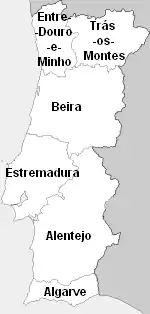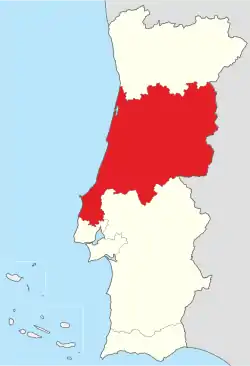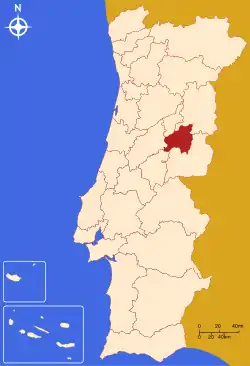Beira (Portugal)
Beira (Portuguese pronunciation: [ˈbɐjɾɐ]) was one of the six traditional provinces or comarcas of Portugal.

The territorial extension is different from that of the area called "The Beiras", which refers to three provinces of 1936, Beira Alta Province, Beira Baixa Province and Beira Litoral Province.
There is also a wine region, called Beira VR.
Geography
The most important cities within the borders of the traditional province are: Coimbra, Aveiro, Leiria, Viseu, Castelo Branco, Guarda, Figueira da Foz, Covilhã and Pinhel.
The main river is the Mondego; other rivers include the Vouga, Dão, Côa, Zêzere and Paiva. The largest mountain range is Serra da Estrela – Continental Portugal's highest – other ranges being the Caramulo, Marofa, Gardunha, and Bussaco.
Administrative history
After the 15th Century, the new Kingdom of Portugal was divided into six great administrative units, referred to as comarcas. Since the Middle Ages there existed the Beira Province.
1936
In 1936 these were divided among three provinces, one of which contained area that was not included in Beira Province:
- Beira Alta Province - "natural" regions of Beira Alta and Beira Transmontana
- Beira Baixa Province
- Beira Litoral Province
Sometimes collectively referred to as "the Beiras".
Some Portuguese geographers referred to the part of Trás-os-Montes that lies south of the Douro River as "Beira Transmontana", but that name was never used officially.
1976
In 1976 the provinces were abolished leaving only the 18 districts.
- Beira Alta Province:
- Beira Baixa Province:
- Beira Litoral Province:
1976 postal code areas divide the area in
- Beira Interior
- Beira Litoral (postal region)
1998
Law 19/98 which was proposed in 1998 divided the area into
- Beira Litoral
- Beira Interior
2011
The current Centro Region of Portugal covers roughly the same area. Oeste Subregion, part of Estremadura, is the major exception. Among its twelve subregions three contain the name "Beira":
The name also is contained in the name of many small towns and villages in the area, e.g. Moimenta da Beira, Celorico da Beira, Aguiar da Beira, Mondim da Beira etc.
Maps
 Medieval Beira
Medieval Beira 1936 Beira Alta
1936 Beira Alta 1936 Beira Baixa
1936 Beira Baixa 1936 Beira Litoral
1936 Beira Litoral postal code regions yellow Beira Litoral, brown Beira Interior
postal code regions yellow Beira Litoral, brown Beira Interior 1998 Law - Beira Litoral and Beira Interior
1998 Law - Beira Litoral and Beira Interior



See also
- Centro, Portugal
- Beira, Mozambique
- Prince of Beira, a former royal title
- Beiras VR, a wine region
- Administrative divisions of Portugal